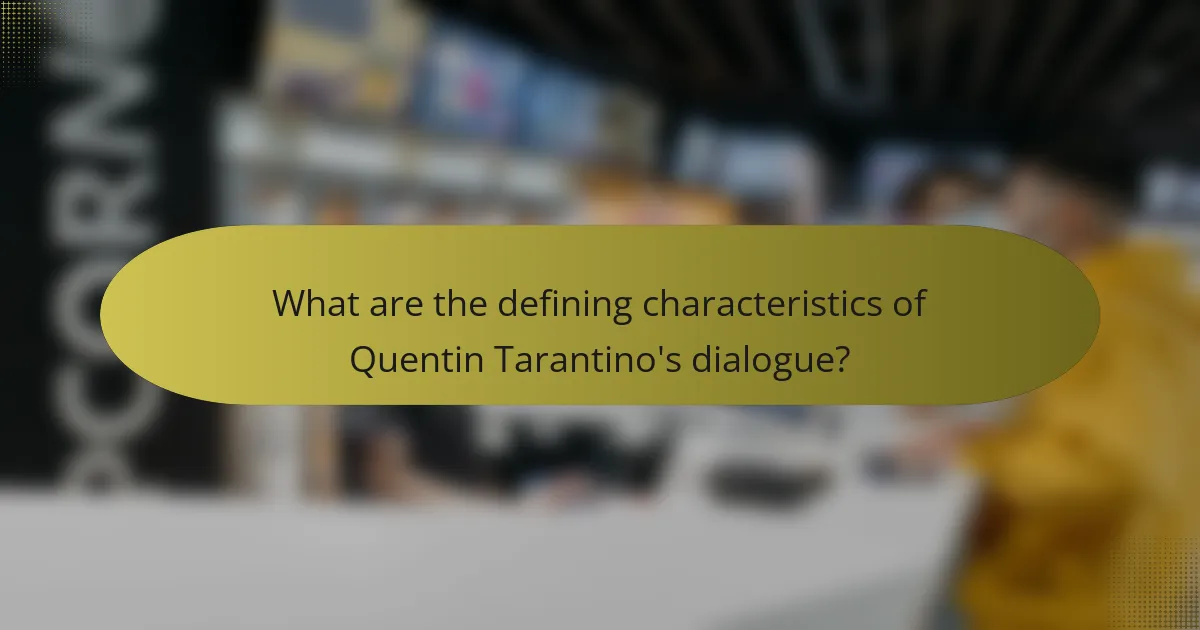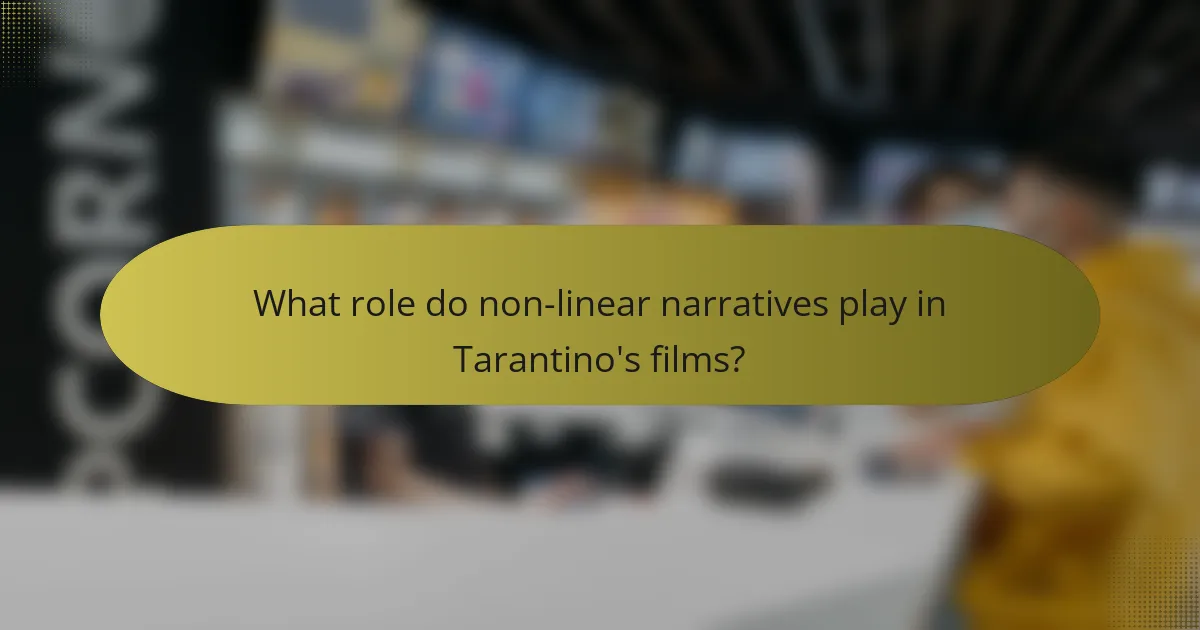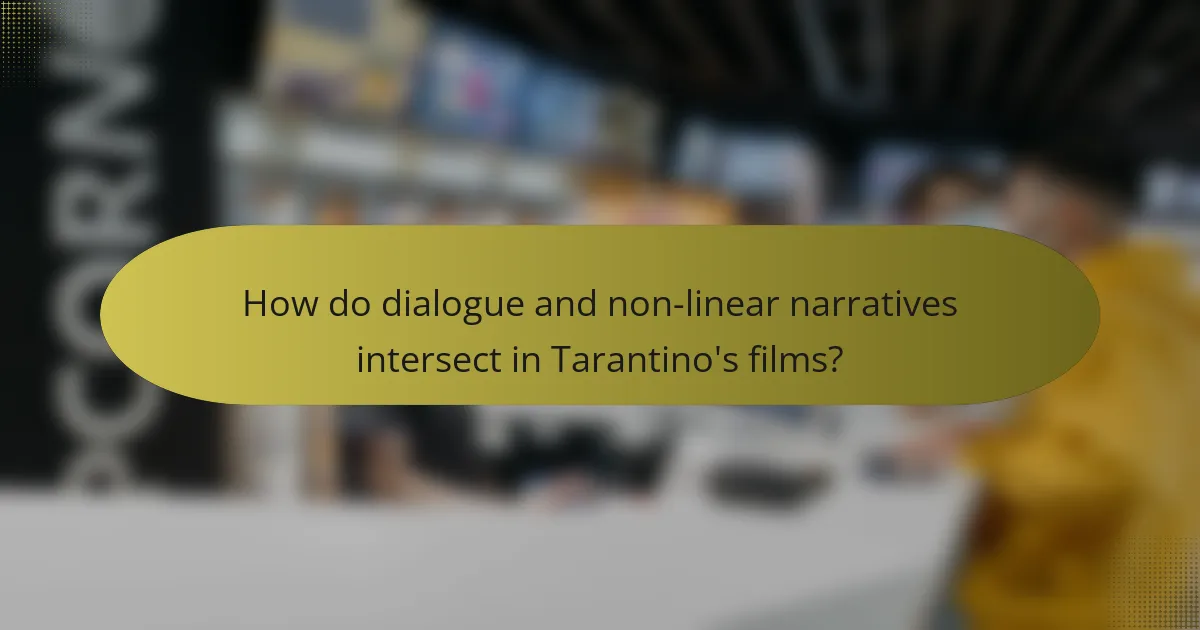Quentin Tarantino is a renowned filmmaker known for his distinctive dialogue and non-linear narrative structures. His dialogue is marked by sharp wit, cultural references, and the use of profanity, enhancing character authenticity and development. Tarantino’s films often feature non-linear storytelling, which creates suspense and encourages viewer engagement through fragmented timelines. This article explores how Tarantino’s unique dialogue intersects with his non-linear narratives, examining their impact on character interactions, thematic elements, and overall storytelling complexity in films like “Pulp Fiction.” The analysis highlights how these techniques contribute to Tarantino’s influence on modern screenwriting and cinematic experiences.

What are the defining characteristics of Quentin Tarantino’s dialogue?
Quentin Tarantino’s dialogue is characterized by sharp wit, cultural references, and non-linear storytelling. His characters often engage in lengthy conversations that reveal their personalities. These dialogues include pop culture references that create a relatable context. Tarantino’s use of profanity adds authenticity to his characters. He employs monologues that serve as pivotal plot devices. His dialogue often blends humor with tension, enhancing dramatic moments. The rhythm and pacing of his lines contribute to the film’s overall tone. Tarantino’s unique style has influenced modern screenwriting, making his dialogue instantly recognizable.
How does Tarantino’s dialogue differ from traditional screenplay writing?
Tarantino’s dialogue is characterized by its distinctiveness compared to traditional screenplay writing. His dialogue often includes extensive monologues and conversations that reveal character depth. Unlike conventional scripts, he employs pop culture references that resonate with audiences. Tarantino’s characters frequently engage in casual, realistic banter, which enhances authenticity. Furthermore, his dialogue often serves as a vehicle for tension and conflict. In contrast, traditional screenwriting usually prioritizes brevity and directness. Tarantino’s style allows for longer, more elaborate exchanges. This approach contributes to building a unique narrative rhythm in his films.
What unique techniques does Tarantino use in his dialogue?
Quentin Tarantino employs several unique techniques in his dialogue. He often uses long, engaging conversations that reveal character depth. His dialogue frequently includes pop culture references, creating relatability. Tarantino’s characters often engage in mundane discussions that build tension. He uses non-linear storytelling, making dialogue pivotal in understanding plot. His characters have distinct voices, reflecting their backgrounds and personalities. Tarantino also blends humor with violence in dialogue, creating a unique tone. His use of repetition emphasizes key themes and ideas. These techniques contribute to his distinctive cinematic style.
How does character voice influence dialogue in Tarantino’s films?
Character voice significantly influences dialogue in Tarantino’s films by shaping tone and authenticity. Each character’s distinct voice reflects their background, personality, and motivations. This diversity creates dynamic interactions that enhance storytelling. For instance, the use of regional dialects and specific vernacular adds realism. Tarantino often crafts dialogues that feel natural, even in extreme situations. The characters’ unique voices drive the narrative forward and reveal their inner conflicts. This technique engages the audience and deepens emotional connections. Tarantino’s mastery of character voice contributes to his films’ memorable and impactful dialogue.
Why is dialogue important in Tarantino’s storytelling?
Dialogue is important in Tarantino’s storytelling because it reveals character depth and drives the plot. His characters often engage in lengthy conversations that explore their motivations and backgrounds. This dialogue creates tension and builds suspense within scenes. It also serves to establish a unique voice and style that is recognizable in his films. Tarantino’s dialogue frequently includes pop culture references, adding layers of meaning. This technique engages the audience and makes the narrative more relatable. Additionally, the rhythm and cadence of his dialogue contribute to the overall pacing of the film. His approach to dialogue transforms ordinary exchanges into memorable moments that resonate with viewers.
How does dialogue contribute to character development?
Dialogue significantly contributes to character development by revealing personal traits and motivations. Through dialogue, characters express their thoughts, emotions, and relationships with others. This interaction allows audiences to understand their complexities and conflicts. For instance, in Quentin Tarantino’s films, characters often engage in lengthy conversations that expose their backstories and desires. Such exchanges provide insight into their moral dilemmas and personal growth. Tarantino’s unique style often features sharp, witty dialogue that reflects the characters’ personalities. This technique enhances the viewer’s connection to the characters, making them more relatable and memorable.
In what ways does dialogue enhance the film’s themes?
Dialogue enhances a film’s themes by revealing character motivations and conflicts. It provides insight into the characters’ inner lives and relationships. In Quentin Tarantino’s films, dialogue often reflects cultural references and societal issues. This creates a deeper connection between the audience and the film’s themes. For instance, in “Pulp Fiction,” conversations about morality highlight the complexity of the characters. This use of dialogue enriches the narrative and emphasizes key thematic elements. Additionally, Tarantino’s unique style often includes witty banter, which can juxtapose serious themes with humor. This contrast helps to engage the audience while exploring darker subjects. Overall, dialogue serves as a critical tool in expressing and enhancing the film’s thematic depth.

What role do non-linear narratives play in Tarantino’s films?
Non-linear narratives in Tarantino’s films serve to enhance storytelling complexity and viewer engagement. They allow for a fragmented presentation of events, which creates suspense and intrigue. This technique encourages audiences to piece together the story, fostering active participation. Films like “Pulp Fiction” exemplify this approach, as they interweave multiple timelines and perspectives. The non-linear structure often leads to unexpected revelations and character development. Tarantino’s use of this narrative style challenges traditional storytelling norms. It invites viewers to reconsider cause and effect within the plot. Overall, non-linear narratives are a hallmark of Tarantino’s cinematic style, enriching the narrative experience.
How does a non-linear narrative structure affect audience engagement?
A non-linear narrative structure enhances audience engagement by creating intrigue and encouraging active participation. This structure allows viewers to piece together the story from various timelines and perspectives. As a result, it fosters deeper emotional connections with characters. Audiences are often more invested when they must solve the narrative puzzle. Research indicates that non-linear storytelling can increase retention of information and emotional responses. For example, films like “Pulp Fiction” effectively use this technique to maintain viewer interest. The non-linear approach challenges traditional storytelling norms, making the experience more memorable.
What are the key elements of non-linear storytelling in Tarantino’s work?
Key elements of non-linear storytelling in Tarantino’s work include fragmented narratives, non-chronological timelines, and character-driven perspectives. Fragmented narratives present events out of order, creating suspense and intrigue. Non-chronological timelines allow for flashbacks and flash-forwards, enhancing thematic depth. Character-driven perspectives provide unique insights into motivations and backstories. These elements are evident in films like “Pulp Fiction” and “Kill Bill,” where the structure challenges traditional storytelling. Tarantino’s approach encourages viewers to piece together the story, fostering engagement and discussion.
How do flashbacks and flash-forwards function in his narratives?
Flashbacks and flash-forwards in Quentin Tarantino’s narratives serve to enhance storytelling and character development. They provide context by revealing past events or future outcomes that influence the present narrative. This technique creates suspense and intrigue, as viewers piece together the timeline. For example, in “Pulp Fiction,” the non-linear structure allows for character backstories to emerge at critical moments. This approach deepens audience engagement by challenging their perception of time and causality. Tarantino’s use of these devices is intentional, crafting a unique viewing experience that encourages active interpretation.
Why does Tarantino choose non-linear narratives over traditional linear ones?
Tarantino chooses non-linear narratives to enhance storytelling complexity and engage the audience. This approach allows for a unique exploration of character development and thematic depth. Non-linear structures create suspense by revealing information out of chronological order. They encourage viewers to piece together the narrative actively. This technique can lead to a more immersive experience. Tarantino’s films often feature intersecting storylines that challenge traditional storytelling. For instance, “Pulp Fiction” showcases multiple perspectives that enrich the plot. This style has become a signature of Tarantino’s filmmaking, differentiating him from conventional directors.
What advantages do non-linear narratives offer in terms of plot twists?
Non-linear narratives enhance plot twists by creating suspense and surprise. This structure allows for the manipulation of time and perspective. Events can be presented out of chronological order, leading to unexpected revelations. By withholding information, these narratives keep audiences guessing. Non-linear storytelling can also reveal character motivations gradually. This layered approach adds depth to plot twists. Research shows that non-linear narratives can increase viewer engagement. A study by the University of Southern California found that audiences are more invested in stories with complex timelines.
How does non-linear storytelling influence character arcs?
Non-linear storytelling significantly influences character arcs by allowing for complex development and deeper emotional resonance. It enables viewers to see characters in various contexts and timelines, which can alter their perceptions. This technique often reveals motivations and backstories at strategic points, enhancing character depth. For example, in Quentin Tarantino’s films, characters may appear in flashbacks or out of chronological order. This approach creates suspense and engages the audience in piecing together the narrative. As a result, character transformations become more impactful. The audience experiences growth and change in characters through fragmented storytelling, making the arcs feel richer and more nuanced.

How do dialogue and non-linear narratives intersect in Tarantino’s films?
Dialogue and non-linear narratives intersect in Tarantino’s films through their intricate relationship in storytelling. His films often feature sharp, witty dialogue that enhances character development. This dialogue occurs within a non-linear narrative structure, which disrupts chronological storytelling. For example, “Pulp Fiction” showcases multiple storylines that intertwine through character interactions. The dialogue in these scenes often foreshadows events or reveals character motivations. This technique creates tension and engages the audience more deeply. Tarantino’s use of dialogue also serves to establish thematic elements across different timelines. The intersection of these elements results in a unique cinematic experience that is both engaging and thought-provoking.
What impact does the interplay between dialogue and narrative structure have on storytelling?
The interplay between dialogue and narrative structure significantly enhances storytelling. Dialogue reveals character motivations and emotions, driving the plot forward. In non-linear narratives, such as those used by Quentin Tarantino, dialogue can create suspense and intrigue. It allows for character development in fragmented timelines. For instance, in “Pulp Fiction,” conversations connect disparate scenes, enriching the overall narrative. This technique encourages audience engagement and deeper analysis. The unique structure challenges traditional storytelling, making the dialogue essential for coherence. Therefore, the combination of dialogue and narrative structure shapes the audience’s experience and understanding of the story.
How does Tarantino use dialogue to foreshadow events in a non-linear narrative?
Tarantino uses dialogue to foreshadow events by embedding hints and clues within character conversations. This technique creates anticipation for future plot developments. For example, in “Pulp Fiction,” the discussion about the “gold watch” foreshadows the watch’s significance later in the story. Characters often reference past events that resonate with future actions, establishing a narrative connection. Tarantino’s characters frequently engage in seemingly trivial dialogue that later reveals deeper meanings. This method enriches the viewing experience by encouraging audiences to piece together the story. The non-linear structure enhances this effect, as viewers can revisit earlier dialogues with new context.
In what ways does dialogue reveal character motivations within a non-linear framework?
Dialogue reveals character motivations by providing insights into their thoughts and emotions. In a non-linear framework, dialogue can be juxtaposed against various timelines. This contrast allows for deeper understanding of motivations as characters reveal their desires and fears in different contexts. For instance, a character’s dialogue in a flashback may expose past traumas that inform their current actions. Additionally, the use of fragmented dialogue can highlight inconsistencies in a character’s motivations. This technique encourages the audience to piece together the character’s psyche. Tarantino often employs this method to create suspense and intrigue. By analyzing the dialogue, viewers can infer motivations that might not be explicitly stated. This layered approach enriches character development and enhances narrative complexity.
What are some best practices for analyzing Tarantino’s dialogue and narrative style?
To analyze Tarantino’s dialogue and narrative style effectively, focus on key elements such as character development, thematic motifs, and non-linear storytelling. Examine how Tarantino uses dialogue to reveal character traits and motivations. Pay attention to the way conversations often blend humor and tension. Analyze the use of pop culture references as a narrative device. Observe the structure of his films, noting how he interweaves timelines to create suspense. Consider the pacing of dialogue, which often features long takes and dynamic exchanges. Additionally, study the impact of sound design and music on the narrative flow. These practices will provide a comprehensive understanding of Tarantino’s distinctive style.
How can viewers apply these insights to appreciate his films more deeply?
Viewers can apply insights about Quentin Tarantino’s unique dialogue and non-linear narratives to appreciate his films more deeply by analyzing character interactions. Understanding the subtext in dialogue reveals deeper emotional connections. Recognizing non-linear storytelling enhances comprehension of plot intricacies. Observing how scenes are juxtaposed can illuminate thematic elements. Research indicates that Tarantino’s dialogue often contains cultural references, enriching viewer engagement. Analyzing these references can provide context and layers to the narrative. Additionally, studying character arcs across the non-linear timeline can deepen emotional investment in the story. Engaging with these elements fosters a more nuanced viewing experience.
What resources are available for further exploration of Tarantino’s techniques?
Books and documentaries are available for further exploration of Tarantino’s techniques. “Quentin Tarantino: The Man, The Myths and His Movies” by Ian Nathan provides insights into his filmmaking style. “The Cinema of Quentin Tarantino” by Edward Gallafent analyzes his narrative methods. Documentaries like “The Director’s Chair” feature interviews with Tarantino discussing his creative process. Online courses on platforms like MasterClass offer lessons on screenwriting and directing from Tarantino himself. Additionally, film analysis websites and forums discuss his unique dialogue and non-linear storytelling. These resources collectively enhance understanding of his artistic approach.
Quentin Tarantino’s Unique Dialogue and Non-Linear Narratives are central to his filmmaking style, characterized by sharp wit, cultural references, and extensive character-driven conversations. This article examines how Tarantino’s dialogue differs from traditional screenplay writing, highlighting its role in character development and thematic expression. It also explores the impact of non-linear narratives on audience engagement and storytelling complexity, detailing techniques such as flashbacks and foreshadowing. Key elements of Tarantino’s approach, including the interplay between dialogue and narrative structure, are analyzed to provide insights into his distinctive cinematic techniques.